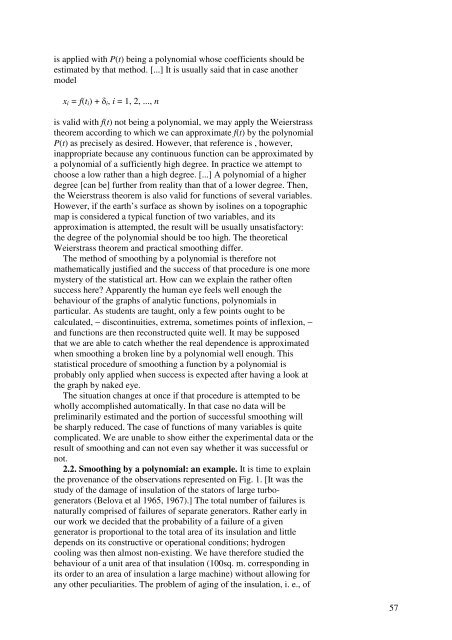1 Studies in the History of Statistics and Probability ... - Sheynin, Oscar
1 Studies in the History of Statistics and Probability ... - Sheynin, Oscar
1 Studies in the History of Statistics and Probability ... - Sheynin, Oscar
You also want an ePaper? Increase the reach of your titles
YUMPU automatically turns print PDFs into web optimized ePapers that Google loves.
is applied with P(t) be<strong>in</strong>g a polynomial whose coefficients should beestimated by that method. [...] It is usually said that <strong>in</strong> case ano<strong>the</strong>rmodelx i = f(t i ) + δ i , i = 1, 2, ..., nis valid with f(t) not be<strong>in</strong>g a polynomial, we may apply <strong>the</strong> Weierstrass<strong>the</strong>orem accord<strong>in</strong>g to which we can approximate f(t) by <strong>the</strong> polynomialP(t) as precisely as desired. However, that reference is , however,<strong>in</strong>appropriate because any cont<strong>in</strong>uous function can be approximated bya polynomial <strong>of</strong> a sufficiently high degree. In practice we attempt tochoose a low ra<strong>the</strong>r than a high degree. [...] A polynomial <strong>of</strong> a higherdegree [can be] fur<strong>the</strong>r from reality than that <strong>of</strong> a lower degree. Then,<strong>the</strong> Weierstrass <strong>the</strong>orem is also valid for functions <strong>of</strong> several variables.However, if <strong>the</strong> earth’s surface as shown by isol<strong>in</strong>es on a topographicmap is considered a typical function <strong>of</strong> two variables, <strong>and</strong> itsapproximation is attempted, <strong>the</strong> result will be usually unsatisfactory:<strong>the</strong> degree <strong>of</strong> <strong>the</strong> polynomial should be too high. The <strong>the</strong>oreticalWeierstrass <strong>the</strong>orem <strong>and</strong> practical smooth<strong>in</strong>g differ.The method <strong>of</strong> smooth<strong>in</strong>g by a polynomial is <strong>the</strong>refore notma<strong>the</strong>matically justified <strong>and</strong> <strong>the</strong> success <strong>of</strong> that procedure is one moremystery <strong>of</strong> <strong>the</strong> statistical art. How can we expla<strong>in</strong> <strong>the</strong> ra<strong>the</strong>r <strong>of</strong>tensuccess here? Apparently <strong>the</strong> human eye feels well enough <strong>the</strong>behaviour <strong>of</strong> <strong>the</strong> graphs <strong>of</strong> analytic functions, polynomials <strong>in</strong>particular. As students are taught, only a few po<strong>in</strong>ts ought to becalculated, − discont<strong>in</strong>uities, extrema, sometimes po<strong>in</strong>ts <strong>of</strong> <strong>in</strong>flexion, −<strong>and</strong> functions are <strong>the</strong>n reconstructed quite well. It may be supposedthat we are able to catch whe<strong>the</strong>r <strong>the</strong> real dependence is approximatedwhen smooth<strong>in</strong>g a broken l<strong>in</strong>e by a polynomial well enough. Thisstatistical procedure <strong>of</strong> smooth<strong>in</strong>g a function by a polynomial isprobably only applied when success is expected after hav<strong>in</strong>g a look at<strong>the</strong> graph by naked eye.The situation changes at once if that procedure is attempted to bewholly accomplished automatically. In that case no data will beprelim<strong>in</strong>arily estimated <strong>and</strong> <strong>the</strong> portion <strong>of</strong> successful smooth<strong>in</strong>g willbe sharply reduced. The case <strong>of</strong> functions <strong>of</strong> many variables is quitecomplicated. We are unable to show ei<strong>the</strong>r <strong>the</strong> experimental data or <strong>the</strong>result <strong>of</strong> smooth<strong>in</strong>g <strong>and</strong> can not even say whe<strong>the</strong>r it was successful ornot.2.2. Smooth<strong>in</strong>g by a polynomial: an example. It is time to expla<strong>in</strong><strong>the</strong> provenance <strong>of</strong> <strong>the</strong> observations represented on Fig. 1. [It was <strong>the</strong>study <strong>of</strong> <strong>the</strong> damage <strong>of</strong> <strong>in</strong>sulation <strong>of</strong> <strong>the</strong> stators <strong>of</strong> large turbogenerators(Belova et al 1965, 1967).] The total number <strong>of</strong> failures isnaturally comprised <strong>of</strong> failures <strong>of</strong> separate generators. Ra<strong>the</strong>r early <strong>in</strong>our work we decided that <strong>the</strong> probability <strong>of</strong> a failure <strong>of</strong> a givengenerator is proportional to <strong>the</strong> total area <strong>of</strong> its <strong>in</strong>sulation <strong>and</strong> littledepends on its constructive or operational conditions; hydrogencool<strong>in</strong>g was <strong>the</strong>n almost non-exist<strong>in</strong>g. We have <strong>the</strong>refore studied <strong>the</strong>behaviour <strong>of</strong> a unit area <strong>of</strong> that <strong>in</strong>sulation (100sq. m. correspond<strong>in</strong>g <strong>in</strong>its order to an area <strong>of</strong> <strong>in</strong>sulation a large mach<strong>in</strong>e) without allow<strong>in</strong>g forany o<strong>the</strong>r peculiarities. The problem <strong>of</strong> ag<strong>in</strong>g <strong>of</strong> <strong>the</strong> <strong>in</strong>sulation, i. e., <strong>of</strong>57









